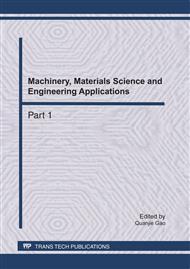p.1
p.5
p.10
p.17
p.23
p.29
p.34
p.38
Dynamic Mechanical Properties of Porous Rock under Impact Loading
Abstract:
Dynamic impact experiments of man-made rock were carried out with the Split Hopkinson Pressure Bar (SHPB) apparatus in this paper. The impact process was analyzed and the influence of rock porosity on dynamic mechanical behavior was investigated. The stress-strain curves in rock were obtained by the one-dimensional stress wave theory. The curve lays foundation for numeric simulation of rock fracture under impact loading. The damage profiles of rock specimen under the impact loading show that the man-made rock exhibits obvious shear damage under the impact loading because it is a typical porous medium containing large quantities of defects such as pores, cracks and grain boundaries at the microscale. The experimental results also indicated that rock porosity plays an important role in dynamic mechanical behavior.
Info:
Periodical:
Pages:
5-9
Citation:
Online since:
April 2011
Authors:
Price:
Сopyright:
© 2011 Trans Tech Publications Ltd. All Rights Reserved
Share:
Citation:


